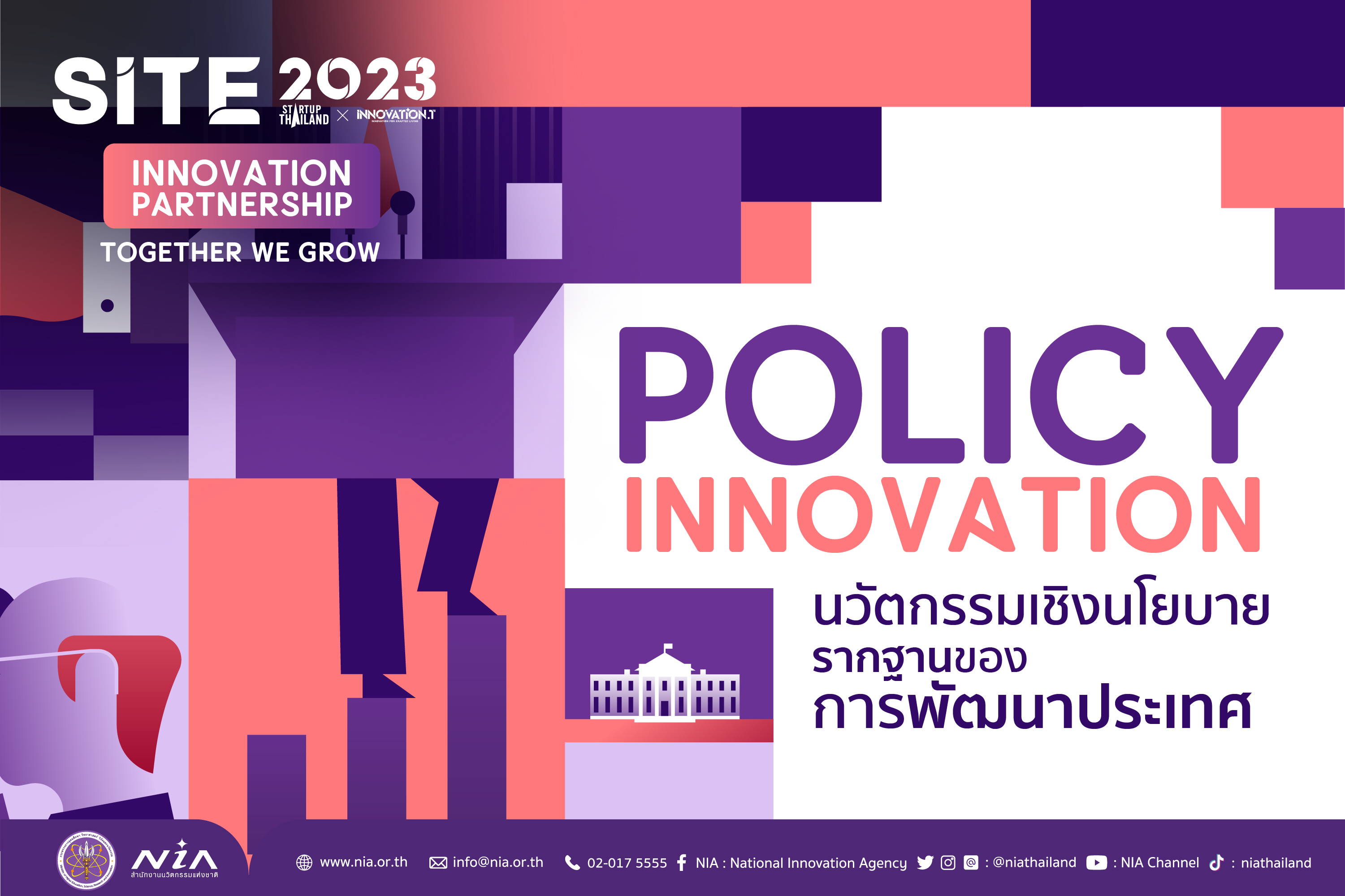- เกี่ยวกับเรา

เกี่ยวกับเรา
สำนักงานนวัตกรรมแห่งชาติ (องค์การมหาชน)
- บริการ

บริการ
การให้บริการของ NIA
- ข่าวสาร/บทความ

ข่าวสาร/บทความ
ความเคลื่อนไหวของ NIA
- ติดต่อเรา/แจ้งปัญหา

ติดต่อเรา/แจ้งปัญหา
ช่องทางในการติดต่อกับ NIA
Policy Innovation นวัตกรรมเชิงนโยบาย รากฐานของการพัฒนาประเทศ
23 มีนาคม 2566 17,836Let's together build "Innovation Partnerships" to bring Thailand towards innovation at Startup x Innovation Thailand Expo 2023

ร่วมสร้าง “หุ้นส่วนนวัตกรรม” เพื่อนำไทยสู่ชาตินวัตกรรมไปพร้อมกันได้ใน
Startup x Innovation Thailand Expo 2023 หรือ SITE 2023
งานมหกรรมนวัตกรรมและเครือข่ายสตาร์ทอัพไทยที่ยิ่งใหญ่ที่สุดในประเทศ!
ระหว่างวันที่ 22 - 24 มิถุนายน 2566 เร็ว ๆ นี้
เมื่อ…นโยบาย ไม่ใช่แค่เรื่องของใครคนใดคนหนึ่งแต่เรื่องของเราทุกคนในฐานะ “พลเมือง” การที่ประเทศชาติจะพัฒนาได้ต้องอาศัยความร่วมมือร่วมใจจากทุกภาคส่วน ตั้งแต่กระบวนการคิด การวางแผนและออกแบบนโยบายที่จะกลายมาเป็นกรอบแนวคิดและโครงสร้างพื้นฐานในดำเนินงานต่อไป โดยรัฐในฐานะผู้วางรากฐานและกำหนดทิศทางของแผนพัฒนาประเทศจะต้องคำนึงหลัก “Citizen-Centered Design” ซึ่งก็คือกระบวนการออกแบบโดยใช้มุมมองและความเข้าใจประชาชนมายึดเป็นหลักในการตัดสินใจ เพื่อที่จะให้สิ่งที่ถูกสร้างออกมาตอบโจทย์และสามารถช่วยเหลือประชาชนได้มากที่สุด
สิ่งสำคัญต่อมาคือ เมื่อรู้หลักการในการออกแบบ “นโยบาย (Policy)” ที่ตอบโจทย์ประชาชนแล้ว “นวัตกรรม (Innovation)” มีส่วนช่วยหรือเกี่ยวข้องกันอย่างไร บทความนี้มีคำตอบ!
Policy Innovation หรือ นวัตกรรมเชิงนโยบาย หลายคนหากได้ยินชื่อนี้คงจะรู้สึกว่าไกลตัวมาก แต่รู้หรือไม่ว่าสิ่งนี้ใกล้ตัวเรากว่าที่คิด!
นวัตกรรมเชิงนโยบาย เป็นการออกแบบหรือสร้าง “กระบวนการทางนโยบาย” (Policy process) โดยการสร้างการมีส่วนร่วมจากทุกภาคส่วน เช่น รัฐ เอกชน ภาคการศึกษา สื่อมวลชน ประชาสังคม ฝ่ายความมั่นคง การเมือง หรือที่เรียกว่า Steakholder เข้ามาออกแบบและสร้างกระบวนการนโยบายร่วมกัน
โดยจะต้อง “เปิดกว้างรับฟัง พร้อมที่จะปรับเปลี่ยนมุมมอง ความคิดและทัศนคติ” (Mindsets & Attitude) เพราะคนเราต่างมีประสบการณ์ที่ต่างกัน อยู่ในบริบทที่ต่างกัน และเชื่อในความคิดของตนเอง ดังนั้น อีกหนึ่งความสำคัญของการทำนวัตกรรมเชิงนโยบายเรื่องของมุมมองความคิด และทัศนคติจึงสำคัญ
และองค์ประกอบสุดท้ายของนวัตกรรมเชิงนโยบายคือ “การใช้หรือสร้างเครื่องมือ” (Utilisation & Buidling of Policy Tools) เพื่อให้ได้มาซึ่ง “นโยบายสาธารณะ” (Public Policy) ใน “รูปแบบใหม”่ (Newness) ที่นําไปสู่ “การปรับใช้ได้จริง” (Policy Deployment)
ดังนั้น "Policy Innovation" จึงไม่ใช่นโยบายที่เกี่ยวกับนวัตกรรม แต่คือ “การนำนวัตกรรมมาใช้ตลอดกระบวนการคิด วางแผน และออกแบบนโยบาย” ซึ่งไม่ใช่เพียงการออกแบบและพัฒนานวัตกรรม เพื่อแก้ไขปัญหาเฉพาะจุดเฉพาะคน หากแต่ต้องมีการนําระบบจัดการเชิงนโยบายเข้ามาเป็นองค์ประกอบ เพื่อให้เกิดการขยายผลอย่างกว้างขวางและเป็นระบบ
สำนักงานนวัตกรรมแห่งชาติ (องค์การมหาชน) หรือ NIA แบ่งนวัตกรรมเชิงนโยบายไว้เป็น 6 มิติ ดังนี้
- นวัตกรรมกระบวนการมีส่วนร่วม (Participatory Process Innovation) คือ การสร้างการมีส่วนร่วมเพื่อประชาธิปไตยในประเทศไทย กระตุ้นให้ภาคประชาสังคมเข้ามามีส่วนร่วม มีบทบาท เรื่องของนโยบายสาธารณะ เช่น การสร้างแพลตฟอร์ม Civic Tech
- นวัตกรรมที่ขับเคลื่อนด้วยข้อมูล (Data-Driven Innovation) คือ การใช้ข้อมูลเพื่อให้เกิดความแม่นยำในการออกแบบนโยบายทั้งระยะสั้น ระยะยาว แก้ปัญหาต่างๆ หรือใช้เพื่อคาดการณ์อนาคตเพื่อรับมือสิ่งต่างๆ ที่จะเกิดขึ้น เช่น การรับมือภัยพิบัติ หรือระบบสาธารณสุข โรคอุบัติใหม่ต่างๆ เป็นต้น
- นวัตกรรมทางการเมือง (Political Innovation) คือ การนำนวัตกรรมมาใช้กับการเมือง ไม่ว่าจะเป็นการนำเทคโนโลยีมาใช้กับระบบการเลือกตั้งออนไลน์ และการยอมรับกระบวนการ ข้อกฎหมายต่างๆ ร่วมกัน กระบวนการยอมรับการมีส่วนร่วมทางการเมือง ทั้งนักการเมืองและพรรคการเมืองให้เป็นสถาบันทางการเมืองอย่างแท้จริง
- นวัตกรรมการติดตามและประเมินผล (Monitoring and Evaluating Innovation) คือการนำความรู้ทางด้านสถิติมาใช้พัฒนาให้เกิดการเปลี่ยนแปลง
- นวัตกรรมด้านงบประมาณและการลงทุน (Budgeting & Investment Innovation) เช่น ระบบการจัดซื้อจัดจ้างภาครัฐ (E-government Procurement) มีข้อมูลแสดงผลออนไลน์ สามารถสอบค้นและตรวจสอบได้
- นวัตกรรมบริการสาธารณะ (Public Service Innovation) คือ เรื่องของการสร้างความเปลี่ยนแปลงในบริการสาธารณะที่ประชนคาดหวังเพื่อยกระดับคุณภาพชีวิตให้ดีขึ้น เช่น บัตรสวัสดิการแห่งรัฐ
โดย NIA เองก็มีโครงการอบรมบ่มเพาะที่สร้างความเข้าใจเรื่องนวัตกรรมเชิงนโยบายเพื่อสร้างผู้นำการเปลี่ยนแปลงหรือ “Change Maker” ผ่านหลักสูตร Public and Private Chief Innovation Leadership (PPCIL) หลักสูตรอบรมเชิงปฏิบัติการเพื่อพัฒนาความสามารถทางนวัตกรรมสำหรับกลุ่มผู้นำรุ่นใหม่
เพราะการสร้างนวัตกรรมเชิงนโยบาย…ต้องอาศัยแนวทางการคาดการณ์และการมองอนาคต (Foresight) ร่วมกับหลักการออกแบบนโยบาย (Policy Design) ที่ต้องเข้าใจบทบาทของผู้มีส่วนได้ส่วนเสียทั้งหมดที่เกี่ยวข้อง เพื่อใช้สร้างแนวปฏิบัติของความร่วมมือรูปแบบใหม่และสร้างผลลัพธ์ใหม่ที่จะส่งผลให้เกิดการร่วมกันดําเนินการให้นวัตกรรมเชิงนโยบายที่ออกแบบคิดค้นขึ้นสามารถนําไปสู่การปฏิบัติที่มีประสิทธิภาพ ประสิทธิผลและยั่งยืนได้
ติดตามความร่วมมือของ “หุ้นส่วนนวัตกรรม” หรือ Innovation Partnership ได้ในงาน Startup x Innovation Thailand Expo 2023 หรือ SITE 2023 ที่จะถึงนี้ โดยหนึ่งในหน่วยงานสำคัญที่เป็นพลังในการขับเคลื่อน “นวัตกรรมภาครัฐ” และร่วมจัดงานกับเราในปีนี้ก็คือ สำนักงานคณะกรรมการพัฒนาระบบราชการ หรือ ก.พ.ร. ซึ่งจะมาร่วมเสวนาและจัดนิทรรศการแสดงผลงานนวัตกรรมภาครัฐ รวมทั้งกิจกรรม Workshop สนุกๆ ชวนกระตุกความคิด และเรียนรู้เรื่อง Gov Innovation ไปด้วยกัน!
________________________________________________
When it comes to policy, it's not just about any one person, but about all of us as "citizens". In order for a country to develop, it requires cooperation from all sectors, starting from the process of thinking, planning, and designing policies that will become the framework and infrastructure for future operations. As the entity responsible for laying the foundation and setting the direction of the country's development plan, the government must consider the principle of "Citizen-Centered Design", which is a design process that puts the perspective and understanding of the people at the center of decision-making. This ensures that what is created meets the needs of the people and provides the greatest support for the citizens.
The next important thing is how innovation is related or how it helps? The answer is in this article!
Policy Innovation may sound like a distant concept to many people. But did you know that it is actually closer to us than we think?
Policy innovation involves designing or creating a "policy process" that encourages participation from all stakeholders, such as the government, private sector, education sector, media, civil society, security sector, politics, or what is commonly referred to as stakeholders, to collectively design and create effective policies.
In order to achieve policy innovation, we must be open-minded to different mindsets and attitudes, since people have different experiences and beliefs. Therefore, perspective and attitude are significant aspects of policy innovation.
Finally, the last component of policy innovation is the utilization or building of policy tools to create "new" public policies that can be effectively deployed.
Therefore, Policy Innovation is not policy about innovation, but rather "the use of innovation throughout the policy thinking, planning, and design process," which is not just about designing and developing innovations to solve specific problems. Instead, policy management systems must be incorporated to expand and systematize the outcomes widely.
NIA divides policy innovation into 6 dimensions as follows:
- Participatory Process Innovation: Creating participation for democracy in Thailand by encouraging civil society to participate and have a role in public policy, such as creating a Civic Tech platform.
- Data-Driven Innovation: Using data in policy design, problem-solving, or predicting the future to cope with disasters, new diseases, and public health systems, etc.
- Political Innovation: Applying innovations to politics, such as using technology in online elections, accepting legal processes together, and enabling political participation in both politicians and political parties to be genuine institutions.
- Monitoring and Evaluating Innovation: Using statistical knowledge to develop changes.
- Budgeting & Investment Innovation: For example, the e-government procurement system that shows information online which can be searched and verified.
- Public Service Innovation: Creating changes in public services to improve people’s quality of life, such as the welfare card.
NIA has a policy innovation course called Public and Private Chief Innovation Leadership (PPCIL) that aims to cultivate understanding of policy innovation to create "Change Makers" through practical training courses that develop innovation abilities for new generation leaders.
This is because creating policy innovation requires the use of foresight and policy design principles, which require understanding the roles and responsibilities of all involved parties in order to create new collaboration models and generate new results that will lead to effective and sustainable innovation policy implementation.
Let’s see the cooperation of the "Innovation Partnership" at the Startup x Innovation Thailand Expo 2023 (SITE 2023). One of the crucial organizations collaborating with us to drive “public-sector innovation” this year is the Office of the Public Sector Development Commission (OPDC), which will participate in forums, exhibitions, as well as fun workshop activities to encourage innovative thinking and learning about Gov Innovation together!
#NIA #PolicyInnovation #NIA #SITE2023 #StartupThailand #InnovationThailand #InnovationPartnership
บทความที่เกี่ยวข้อง
- บริการ










